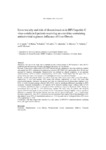Liver toxicity and risk of discontinuation in HIV/hepatitis C virus-coinfected patients receiving an etravirine-containing antiretroviral regimen: influence of liver fibrosis

Ver/
Use este enlace para citar
http://hdl.handle.net/2183/18398Coleccións
- Investigación (FCS) [1293]
Metadatos
Mostrar o rexistro completo do ítemTítulo
Liver toxicity and risk of discontinuation in HIV/hepatitis C virus-coinfected patients receiving an etravirine-containing antiretroviral regimen: influence of liver fibrosisAutor(es)
Data
2015-06-30Cita bibliográfica
Casado JL, Mena A, Bañón S, et al. Liver toxicity and risk of discontinuation in HIV/hepatitis C virus-coinfected patients receiving an etravirine-containing antiretroviral regimen: influence of liver fibrosis. HIV Med. 2016;17(1):62-67
Resumo
[Abstract] Objectives. The aim of the study was to establish the risk of liver toxicity in HIV/hepatitis C virus (HCV)-coinfected patients receiving etravirine, according to the degree of liver fibrosis.
Methods. A prospective cohort study of 211 HIV-infected patients initiating an etravirine-containing regimen was carried out. HCV coinfection was defined as a positive HCV RNA test, and baseline liver fibrosis was assessed by transient elastography. Hepatotoxicity was defined as clinical symptoms, or an aspartate aminotransferase (AST) or alanine aminotransferase (ALT) value > 5-fold higher than the upper limit of normal if baseline values were normal, or 3.5-fold higher if values were altered at baseline.
Results. Overall, 145 patients (69%) were HCV coinfected, with a lower nadir (165 versus 220 cells/μL, respectively; p = 0.03) and baseline (374 versus 498 cells/μL, respectively; p = 0.04) CD4 count than monoinfected patients. Etravirine was mainly used with two nucleoside reverse transcriptase inhibitors (129; 61%) or with a boosted protease inhibitor (PI) (28%), with no significant differences according to HCV serostatus. Transient elastography in 117 patients (81%) showed a median (range) stiffness value of 8.25 (3.5–69) kPa, with fibrosis stage 1 in 43 patients (37%) and fibrosis stage 4 in 28 patients (24%). During an accumulated follow-up time of 449.3 patient-years (median 548 days), only one patient with advanced fibrosis (50.8 kPa) had grade 3–4 liver toxicity (0.7%). Transaminases changed slightly, with no significant differences compared with baseline fibrosis, and nine and six patients had grade 1 and 2 transaminase increases, respectively. Also, HCV coinfection was not associated with a higher risk of discontinuation (25% discontinued versus 21% of monoinfected patients; p = 0.39, log-rank test) or virological failure (8% versus 12%, respectively; p = 0.4).
Conclusions. Our data suggest that etravirine is a safe option for HIV/HCV-coinfected patients, including those with significant liver fibrosis.
Palabras chave
Etravirine
Hepatotoxicity
Liver fibrosis
Nonnucleoside reverse transcriptase inhibitor
Transient elastography
Hepatotoxicity
Liver fibrosis
Nonnucleoside reverse transcriptase inhibitor
Transient elastography
Descrición
Short communication
Versión do editor
Dereitos
This is the peer reviewed version of the article which has been published in final form at Wiley Online Library. This article may be used for non-commercial purposes in accordance with Wiley Terms and Conditions for self-archiving
ISSN
1464-2662
1468-1293
1468-1293





